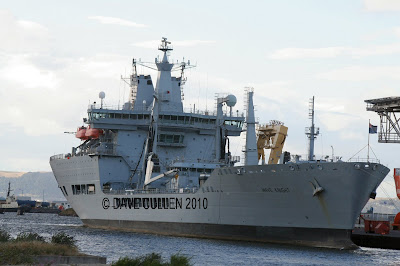Powerful and versatile with the capability to operate anywhere in the world, the type 23 frigate is the mainstay of the modern surface fleet. The 13 Type 23 frigates form 50% of the total frigate/destroyer force in the Royal Navy. Originally designed for the principal task of anti-submarine warfare, they have evolved into powerful and versatile multi purpose ships with the capability to operate anywhere in the world. The effectiveness of these ships is enhanced by their stealth design, which reduces their radar signature significantly. In addition to the war fighting roles described above, the ship is trained to conduct a wide range of other tasks. These include embargo operations using boarding teams inserted from the ship's boats or helicopter, disaster relief work and surveillance operations.
HMS Iron Duke
The current Iron Duke is the third RN Ship to bear the name and 5th of the Duke Class Frigates. Launched on 2 March 1991 by the Ship's Sponsor, Lady Jane King, the wife of the then Secretary of State for Defence, she was commissioned on 30 May 1991. Iron Duke enjoys strong affiliations with her home town of Kingston Upon Hull, the Duke of Wellington's Regiment and the Worshipful Company of Founders. Her motto is "Virtutis Fortuna Comes" (Fortune is the companion of valour).
Seen here departing Rosyth after a refit

Seen here arriving Leith
Alongside the following day
HMS Lancaster
Built by Yarrow Shipbuilders on the Clyde, Lancaster is the fourth of the Type 23 frigates. She was launched by Her Majesty the Queen (Duke of Lancaster) in May 1990 and commissioned 2 years later. The Ship's emblem is the historically famous Lancastrian Red Rose.
The current HMS Lancaster is the sixth to bear the name. She was commissioned in 1992 by Her Majesty the Queen in her official role as Duke of Lancaster who incidentally retains close links as our sponsor. Displacing 4000 tonnes and with a crew of approximately 180, Portsmouth is her home port when not on operational tasking.
Seen here arriving Leith 22nd October 1998
HMS Monmouth
Built by Yarrow Shipbuilders on the Clyde, Monmouth is the sixth of the Type 23 Duke class frigates. She was launched by Lady Eaton in 1991 and commissioned two years later. Affectionately known as the 'Black Duke' (to find out why see the ship's history page), Monmouth is easily recognised by the black flag she flies from the mainmast.
Seen here arriving Leith 29th February 2008
HMS Northumberland
HMS Northumberland was built at Swan Hunters at Wallsend on the Tyne, being launched in April 1992 by the ship's sponsor Lady Kerr. She was accepted into Royal Naval Service in May 1994.
She is affiliated to Northumberland County Council , The Morpeth Pipe Band,The Light Dragoons, TS Tenacity SCC to name but a few. She has and impressive set of battle honours ranging from Barfleur in 1692 to Groix Island in 1812.
Seen here arriving Leith 8th March 1997
HMS Somerset
The present HMS Somerset is the 4th to bear the name and was built by Yarrow Shipbuilders Ltd. She was launched on 24 June 1994 on the Clyde by Lady Elspeth Layard, wife of the then Second Sea Lord Admiral Sir Michael Layard, and commissioned on 20 September 1996, at Devonport, in the presence of Lady Elspeth and his Grace the Duke of Somerset. HMS Somerset maintains close links with both the Duke of Somerset and the County of Somerset . The ship's motto, adopted in 2005 to celebrate Trafalgar 200 and the ship's close connection with the Dukes of Somerset, is the family motto of the Dukes of Somerset:
Seen here departing Faslane 2007

HMS Westminster
HMS WESTMINSTER enjoys excellent relations with the City of Westminster, the Household Cavalry Mounted Regiment, the Worshipful Company of Fanmakers and London Underground (Westminster Station of course!). The ship's motto is "For Nation and for Glory",
Seen here arrivng Leith 22nd February 1997

























































